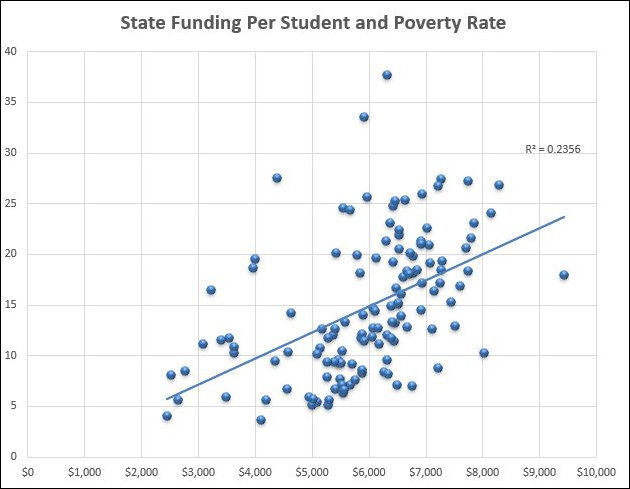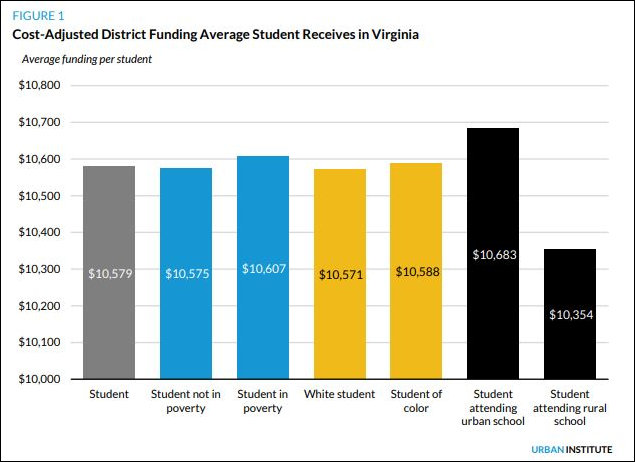by James A. Bacon
The Virginia Board of Education will convene next week to consider a proposal to create a $350 million “equity fund” to pay for additional teachers and targeted compensation, reports Radio IQ. Details of the proposal have not yet been posted on the board website, so we may have to wait until the board meeting to get specifics.
Radio IQ quotes Chris Duncombe at the Commonwealth Institute for Fiscal Analysis as saying that distributing money based on poverty would create more equity in the system. “Virginia actually right now is spending less per student in the school divisions with the highest child poverty rates when you’re looking at state and local funds compared to school divisions with the lowest child poverty rates or the greatest wealth.”
Kristen Blagg with the Urban Institute also says that the special needs of English language learners also need to be considered. “When we are thinking about equity and we are thinking about distributing funds equitably, student poverty is a very important and very large need. But so are the other needs that the students may have.”
What the heck is going on? The state’s funding formula already favors poor school districts! So does federal funding! If total per-student funding is unequal, it’s because the “poor” districts are not taxing within their capacity to pay.
The Urban Institute’s own numbers from this 2018 study show that students in poverty receive almost identical funding on average to students not in poverty, and students “of color” (not clear if that includes Asians or not) receive slightly more than whites. (See graph above.) That’s funding from “the state and local districts.” Conveniently for the case the Urban Institute is making, the numbers exclude federal funding, which is skewed toward high-poverty districts, and they don’t break out state funding so we can see what’s happening there.
The state divvies up its support for K-12 in four buckets: Standard of Quality funding, incentives, categorical, and lottery proceeds. I added up total spending for all categories for each state based on data in the 2017-18 state superintendent’s report, calculated per-student support for each locality, and then plotted that against the poverty rate for each locality. The graph below shows a strong (though far from perfect) correlation between state support and poverty rates.

The correlation is not perfect because some localities — Alexandria and the City of Richmond are good examples — have high poverty rates and high “ability to pay” based upon the strength of their tax bases. Another confounding factor is that these numbers don’t account for vast differences in the cost of living between Northern Virginia, the smaller metros, and rural school districts. But anyone whose memories extend back to the Wilder era when the current funding formula was set into place knows that the purpose was for the state to redress “funding inequities” resulting from the disparity in local ability to pay. In other words, the current formula already has wealth-distribution built in. As a consequence, wealthy Fairfax County/City of Fairfax received $3,498 per student in 2017-18, the affluent City of Richmond received $5,964 per student, and poverty-ridden Charlotte County received $9,433 per student.
Bacon’s bottom line: The state funding formula favors poor districts, and federal funding favors poor districts. But that doesn’t stop the Urban Institute and Commonwealth Institute from decrying funding inequities.
Now, let’s talk about taxing inequities. Middle-class taxpayers are asked to fund the redistributionist schemes of the federal government and the redistributionist schemes of the state government, in addition to supporting their own local schools. Now the Virginia Board of Education is contemplating skimming some $350 million off the top of the $6.7 billion in total state funding (2017-18) — about 5% of the total — in order to devote even more money to schools with poor kids.
If the progressives pushing this proposal want to undermine public support for public education, this is how to do it. It’s one thing to ask middle-class taxpayers to subsidize the education of poor kids to the same level of funding that the taxpayers’ kids are getting. It’s political dynamite to expect middle-class tax payers to spend more on other kids than their own kids — especially when there is precious little evidence that more money makes a difference and that the money won’t run down a rat-hole of failing school districts.
If Republicans had any brains, they’d be pounding this issue hard in the closing days of the General Assembly elections. But I’ve seen no evidence that they have any more intelligence than a glow-worm, so they’re not likely to utter a peep. Of course, you can count on the media to parrot the funding “inequity” angle of the liberal think tanks without conducting the slightest skepticism or searching for alternative views. I’d say the odds are pretty good that this idea will get enshrined in the next budget.
New Jersey, here we come!



